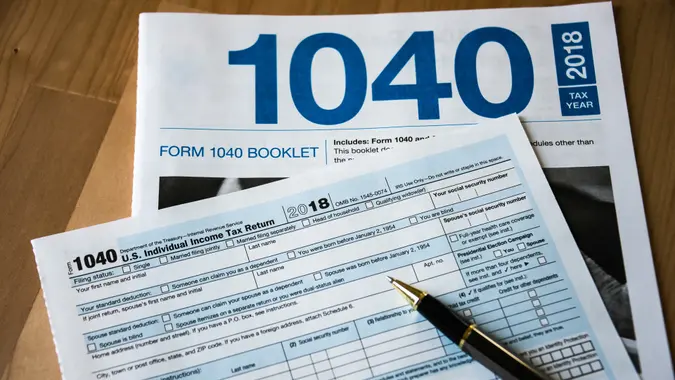Are CDs and Bonds Taxed Differently?

Commitment to Our Readers
GOBankingRates' editorial team is committed to bringing you unbiased reviews and information. We use data-driven methodologies to evaluate financial products and services - our reviews and ratings are not influenced by advertisers. You can read more about our editorial guidelines and our products and services review methodology.

20 Years
Helping You Live Richer

Reviewed
by Experts

Trusted by
Millions of Readers
Both certificates of deposit and Treasury bonds provide predictable, low-risk investment options. However, these two options are different from each other in several important ways. For many investors, the most critical question is: Are CDs and bonds taxed differently?
See Also: Owe Money to the IRS? Most People Don’t Realize You Can Do This
Taxes on CDs: What You Should Know
Investors earn interest on the principal they invest in CDs. That interest is taxed as ordinary income, including both state and federal income tax. The specific rate that individuals will pay depends on their income tax bracket for that tax year.
However, CDs are available with a variety of terms, including some that are 12 months or longer. The initial investment and maturation won’t necessarily fall within the same tax year. For shorter terms, interest is taxed at maturity. For longer terms, accrued interest is taxed for each tax year.
Some investors choose to renew their CDs at maturation. Even if this is the case, interest is still taxed at maturity. For tax purposes, it’s the same as opening a new CD. Closing a CD early typically incurs a penalty against the interest earned. In this case, the total interest must be reported for tax purposes, and the penalty is deductible.
Taxes on Treasury Bonds
U.S. Treasury bonds are a secure investment vehicle that provides a variety of maturity options. Interest earned on bonds does incur federal income tax but not state income tax. The interest from Treasury bonds is only taxable at maturity, being reported in the tax year when it pays out.
Some types of U.S. Treasury bonds have additional tax requirements. Separate trading of registered interest and principal of securities, or STRIPS, has interest taxable during the year it accrues. Treasury inflation-protected securities, or TIPS, adjustments based on inflation incur capital gains tax during that tax year.
U.S. Treasury bonds can also be bought and sold before maturity on secondary markets. These transactions can incur capital gains or losses and are reported and taxed accordingly.
Taking Advantage of Tax-Sheltered Accounts
CDs can be held in tax-sheltered accounts such as an individual retirement account or 401(k). The interest from these CDs is not subject to income tax at the time of accrual. Income tax will have to be paid at the time of IRA distribution, but CDs can continue to be renewed and grow without taxes.
U.S. Treasury bonds can also be held in tax-sheltered accounts such as an IRA or 401(k). However, the critical difference between the two is the state income tax. While both bonds and CDs incur federal income tax, only CDs face state income tax. This means that the tax benefit of holding CDs in an IRA or 401(k) is greater than that of U.S. Treasury bonds.
State income tax varies widely, so the benefits won’t be the same for investors everywhere. Seven states have no individual income tax, meaning there is no difference in taxation between the two assets. The states have no income tax: Alaska, Florida, Nevada, South Dakota, Tennessee, Texas and Wyoming. The remaining 43 states and the District of Columbia do levy state income tax.
The impact of state income tax depends heavily on both the specific state and the individual tax bracket. Top state marginal individual income tax rates range as high as 13.3%, while others are as low as 2.9%. Eleven states have a flat state income tax, so an individual bracket doesn’t apply in those cases.
In states with a high state income tax, U.S. Treasury bonds have a substantial advantage over CDs when held in non-tax-sheltered accounts. However, when held in a tax-sheltered account or in states with no income tax, that advantage disappears.
Other Factors to Consider
Tax on interest is far from the only factor to consider when choosing the right investment. Treasury bonds and CDs vary in many other important ways as well.
The longest maturity available for most CDs is five years, while Treasury bonds are available for up to 30 years. Liquidity is another factor to consider. Treasury bonds are bought and sold on highly active secondary markets, making them more liquid than CDs.
Yield is also an important aspect to consider for any investment. On a short-term basis, the best CD rates are roughly the same as those offered by U.S. Treasury bonds. While performance varies over long periods, current trends point to better long-term yields for Treasury bonds.
Choosing the Right Investment for Your Needs
Depending on any given investor’s financial situation and goals, both CDs and Treasury bonds can be excellent options. Taxation, yields, liquidity, and timelines can all affect which is best for a specific situation. Investors should weigh their options carefully and consider working with a professional financial advisor to plan their investment strategy.
Our in-house research team and on-site financial experts work together to create content that’s accurate, impartial, and up to date. We fact-check every single statistic, quote and fact using trusted primary resources to make sure the information we provide is correct. You can learn more about GOBankingRates’ processes and standards in our editorial policy.
- Forbes Advisor. 2023. "How To Invest In Treasury Bills."
- Charles Schwab. 2023. "CD or Treasury? Five Factors to Consider."
 Written by
Written by  Edited by
Edited by 

























